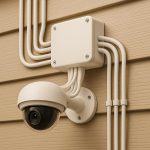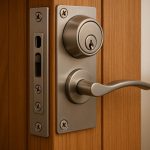Panic and duress alarm systems are emergency tools designed to summon help when calling 911 isn’t possible. These systems are widely used in homes, workplaces, and public spaces to ensure safety during critical situations. Here’s a quick breakdown:
- Panic alarms: Trigger loud sounds and visible alerts to draw immediate attention. Ideal for emergencies like fires or medical crises.
- Duress alarms: Send silent notifications to security or law enforcement, ensuring discretion in sensitive scenarios like robberies or coercion.
- Key differences: Panic alarms are overt, while duress alarms are covert. Panic systems focus on local responses, whereas duress systems notify external responders.
These systems work through physical buttons, mobile apps, or hidden triggers, and can integrate with security setups like cameras and access controls. Proper installation, especially by professionals, ensures reliability and compliance with safety codes. Whether for personal or commercial use, they offer peace of mind and faster emergency responses.
WHAT IS DURESS ALARM SYSTEM
Panic vs. Duress Alarm Systems: Key Differences
When it comes to emergency alert devices, panic and duress alarm systems serve distinct purposes, each tailored to specific scenarios. Understanding these differences is crucial when choosing the right system for a particular threat environment.
Panic alarm systems are designed for situations that demand an immediate and visible response. When activated, they trigger loud alarms, flashing lights, and notify nearby monitoring centers. For instance, a bank teller might press a clearly marked panic button during a robbery, signaling the need for urgent intervention. These systems are overt and meant to draw attention to the emergency.
On the other hand, duress alarm systems operate in complete silence, sending alerts directly to security personnel, monitoring centers, or law enforcement without any external indication. These systems are activated discreetly – often through hidden buttons, specific duress codes entered on keypads, or a silent feature in a smartphone app. This approach is particularly valuable in situations where drawing attention could escalate the danger, such as during a hostage scenario.
The activation methods also differ. Panic systems use large, visible buttons or pull stations that can be easily accessed during a crisis. Duress systems, however, are designed for covert activation, such as entering a duress code alongside a regular disarm code or using a concealed button on a pendant.
The response protocols for these systems are tailored to their purpose. Panic alarms typically trigger an immediate local reaction, such as on-site security arriving, building-wide alerts, or evacuation procedures. In contrast, duress alarms notify external responders – like law enforcement or professional monitoring centers – without alerting the perpetrator, ensuring the situation remains under control.
Comparison Table: Panic vs. Duress Systems
| Feature | Panic Alarm Systems | Duress Alarm Systems |
|---|---|---|
| Activation Method | Large, visible panic buttons or pull stations | Hidden buttons, duress codes, or concealed pendants |
| Alert Type | Audible alarms, flashing lights, visible warnings | Silent alerts sent to monitoring centers |
| Response Speed | Immediate local response | Coordinated external response |
| Discretion Level | Highly visible | Completely discreet |
| Primary Use Cases | Medical emergencies, fires, or visible threats | Hostage situations, coercion, or sensitive scenarios |
| Integration | Often standalone systems with local alerts | Typically integrated with professional monitoring services |
| Cost Range | Generally lower, focusing on individual devices | Higher due to monitoring and system integration |
| Installation Complexity | Straightforward (e.g., wall-mounted or desktop) | Requires professional setup and integration |
The choice between these systems largely depends on the environment and the type of response required. For example, in a healthcare facility, panic systems may be ideal in patient areas where visible alerts are critical, while duress systems might be better suited for administrative offices where discretion is key. In many cases, combining both systems within a security plan ensures comprehensive coverage for a variety of emergencies.
These differences also play a role in how these systems are installed and integrated, which will be explored in the next section.
How These Alarm Systems Work
Alarm systems are designed to send out signals immediately, whether triggered by physical buttons or digital inputs, ensuring swift communication when time is critical.
For physical activation, options include wall-mounted buttons, under-desk switches, and wearable or portable devices. On the digital side, triggers can be activated through keypad codes, mobile app buttons, voice commands, or specific computer inputs.
Once activated, the system alerts the appropriate recipients, such as on-site security teams, central monitoring stations, or even 911 dispatchers. These alerts are sent out through various channels, including phone calls, text messages, desktop notifications, public address systems, or radio communications.
In certain situations, like when someone is under duress, some systems can send silent notifications to avoid drawing attention. On the other hand, panic alarms might activate loud sounds and flashing lights across a facility to ensure everyone is aware. These features are critical to ensuring proper installation and smooth operation.
sbb-itb-643e28e
Where to Use Panic and Duress Alarms
Installing panic and duress alarms in the right locations is essential for protecting both people and property. These systems serve a variety of purposes depending on the environment, and their placement can make a critical difference during emergencies.
Home Use
In homes, panic alarms are often placed near entry points to provide quick access during a break-in. Wall-mounted panic buttons located by entryways, master bedrooms, or home offices allow residents to call for help immediately if an intrusion occurs. For medical emergencies, wearable duress devices are especially helpful. These devices enable individuals – particularly elderly residents or those with chronic health issues – to discreetly signal for assistance during events like a heart attack, stroke, or serious fall. Silent duress alarms are also useful in domestic situations where summoning help discreetly is necessary to avoid alerting an aggressor.
Some home insurance providers may even offer discounts on policies when professionally monitored alarm systems are installed, making these systems a smart safety investment.
Workplaces also require alarms to address specific security concerns.
Business and Workplace Use
Retail businesses frequently install panic buttons at critical points like cash registers, service counters, and back offices. These discreet alarms allow staff to alert security or law enforcement during emergencies without escalating a situation.
Banks rely heavily on panic systems, placing them at teller stations and in offices to handle urgent threats. These systems often include silent alerts to ensure a swift response.
In healthcare settings, panic and duress alarms are vital for protecting staff from potentially aggressive behavior. Hospitals and nursing homes, for example, install these systems in emergency rooms, patient areas, and administrative offices to ensure quick backup in critical situations. Similarly, office buildings are adopting panic systems to address workplace violence. Placing panic buttons in human resources departments, executive offices, and reception areas helps secure the premises during emergencies.
Additionally, installing these systems can help businesses comply with insurance requirements and may even lead to reduced premiums.
Public Buildings and Facilities
Public facilities also benefit from carefully planned alarm placements to enhance safety.
Schools, for instance, are increasingly incorporating panic alarms into their security measures. These alarms may be installed in classrooms, administrative offices, and common areas like cafeterias and gymnasiums, often as part of broader lockdown protocols designed to ensure a rapid response from law enforcement.
Government buildings, which often have strict security standards, use comprehensive panic and duress systems. Courthouses, city halls, and federal buildings rely on these alarms to protect employees and visitors from potential threats.
Places of worship, such as churches, synagogues, and mosques, are also adopting panic systems to enhance safety during services. Discreetly placed panic buttons ensure help can be summoned quickly without disrupting the environment.
Shopping centers and malls deploy panic alarms throughout their facilities to safeguard both retailers and visitors. These alarms are typically found in security offices, individual stores, and common areas, connecting directly to on-site security teams and local police for immediate assistance.
Public facilities must also adhere to regulatory requirements for emergency notifications and accessibility, ensuring that these systems are both effective and compliant.
Choosing and Installing Your Alarm System
Finding the right alarm system means balancing your specific needs, your environment, and your budget. The goal? Reliable protection when it matters most.
What to Consider When Selecting a System
When picking an alarm system, environmental factors are key. For indoor setups, wireless systems are often preferred because they’re easier to install. Outdoor systems, however, need weatherproof components and stronger signals to handle harsher conditions. The size of the area also matters – smaller spaces can often get by with simpler systems, but larger facilities might need equipment with extended range capabilities.
Ease of use is another crucial aspect. Systems should be simple to operate, with features like large buttons and clear indicators. Some even provide voice confirmations, reassuring users that their alert has gone through. If you’re in an environment with multiple staff members, consider systems that allow activation from several locations for added flexibility.
Integration capabilities are worth checking, too. Make sure the alarm can connect seamlessly with your current surveillance or access control systems.
Response protocols vary by system. Some connect directly to law enforcement, while others send alerts to private monitoring companies. These companies may also offer extra services like medical emergency support or system maintenance notifications.
Lastly, don’t overlook power backup. Battery-powered systems can keep running for a limited time during outages, while systems with backup generators offer extended reliability. If you live in an area prone to power interruptions, choosing a system with robust backup options is a smart move.
Once you’ve decided on the features you need, proper installation becomes the next critical step.
Why Professional Installation Matters
A professional installation can make all the difference in how well your system performs during emergencies. Misplaced panic buttons or receivers can lead to dead zones – areas where signals fail to transmit. Certified technicians know how to position equipment for optimal coverage and signal strength.
Professionals also handle programming to ensure that alerts are sent accurately. This means responders will receive the correct details, like your location and the nature of the emergency, without any confusion.
Another key reason to go with professional installation? Code compliance. Local regulations often dictate how alarm systems should be installed, particularly in commercial or public buildings. Experienced installers are familiar with these requirements and will ensure your system meets all the necessary standards.
If you’re in the Pittsburgh area, Sherlock’s Locksmith offers comprehensive security system installation services. Their team of certified technicians manages every step, from assessing your needs to testing the final setup. They also provide 24/7 mobile service, so they’re ready to handle emergency installations or repairs whenever needed.
Once installed, ongoing maintenance is essential to keep your system running smoothly. Many professional installers offer maintenance plans that include tasks like replacing batteries, signal testing, and updating software. These services help prevent failures when you need the system most.
After securing professional installation, it’s time to think about costs and financing options.
System Costs and Pricing
The cost of an alarm system depends largely on its features, coverage, and integration capabilities. For example, basic wireless systems – ideal for homes – are usually more affordable. Mid-range systems, which might include features like smartphone integration or support for multiple users, are better suited for larger spaces. Commercial-grade systems, designed for businesses or large facilities, come with more devices and higher installation and monitoring fees.
Professional installation costs can vary based on the system’s complexity and local regulations. However, a professionally installed system not only ensures safety and compliance but can also lead to discounts on your insurance premiums. Many providers offer bundled packages that include equipment, installation, and the first year of monitoring at a competitive price.
Speaking of insurance, many companies offer premium discounts for properties equipped with professionally monitored systems. This can make a reliable alarm system a valuable long-term investment. Some security providers even offer financing options, making it easier to manage the upfront costs. A properly installed system doesn’t just enhance safety – it can also save you money in the long run.
Conclusion
Panic and duress alarm systems provide immediate emergency assistance, offering critical protection in situations ranging from workplace violence to broader security threats. With over 40,000 non-fatal workplace assaults reported in 2019, having a dependable emergency response system is more than just a precaution – it’s a necessity.
Integrated security systems that reduce emergency response times by up to 50% can mean the difference between resolving an incident quickly and facing a more severe outcome. Whether it’s a silent duress system for discreet alerts or an audible panic system for building-wide notifications, both serve to deter threats and ensure rapid assistance. These systems work best when expertly installed, ensuring they function seamlessly when needed most.
Professional installation, like the services offered by Sherlock’s Locksmith in Pittsburgh, ensures proper system placement, compliance with safety codes, and flawless integration. With 24/7 mobile support, these systems are ready to perform reliably from the very beginning.
The flexibility of these alarm systems makes them effective in a variety of settings, from corporate offices to healthcare facilities. When paired with regular maintenance, employee training, and routine system testing, they create a comprehensive defense against threats that traditional measures might overlook. Moreover, advanced features like AI and IoT connectivity further enhance their reliability and functionality.
One of the most reassuring aspects of these systems is the peace of mind they offer. Knowing that help is just the press of a button away provides a sense of security at work, at home, and in public spaces. As technology evolves, these systems will continue to become even more effective, offering smarter, faster ways to protect what matters most.
Beyond safety, investing in a professionally installed panic or duress alarm system can also lead to financial benefits, such as insurance savings and meeting regulatory requirements. When emergencies arise, having a reliable system in place can make all the difference between managing a situation effectively and facing a potential disaster.
FAQs
What’s the difference between a panic alarm and a duress alarm, and how do I choose the right one?
The decision between a panic alarm and a duress alarm comes down to the kind of response you need – immediate and noticeable or quiet and discreet. A panic alarm is loud, designed to grab the attention of those nearby. It’s a great option for emergencies where making noise is crucial, like during a break-in or physical confrontation. In contrast, a duress alarm works silently, sending a signal directly to authorities or security teams. This makes it ideal for situations where staying under the radar is essential, such as during a robbery or in high-risk workplaces.
When choosing, think about your environment, potential threats, and the type of response required. For instance, homes or small businesses might lean toward panic alarms for quick, public assistance. Meanwhile, duress alarms are better suited for places that prioritize covert safety, like banks or offices handling sensitive operations. If you’re not sure which option fits your needs, reaching out to a security expert can provide clarity and guidance.
What should I look for when hiring a professional to install an alarm system?
When bringing in a professional to install an alarm system, the first step is to verify that the company is licensed and certified. This ensures they adhere to industry standards and regulations. You’ll also want to focus on hiring technicians with solid experience and a proven track record in security system installations. Their expertise can make a big difference in how well the system performs.
Another key factor is checking the company’s reputation and customer reviews. This can give you a clearer picture of their reliability and the quality of their service. Additionally, consider their response times for installation and ongoing support. Having access to 24/7 customer service is a major plus, as it ensures any issues can be addressed promptly. By keeping these points in mind, you’ll be better equipped to select a dependable and skilled service provider.
Can panic and duress alarm systems work with my current security setup, and what are the advantages?
Yes, panic and duress alarm systems can work effortlessly with your current security setup, including surveillance cameras, access control systems, and monitoring services. This connection boosts safety by allowing quicker emergency responses, better alarm verification, and fewer false alarms.
Integrating these alarms with your existing system gives you centralized control and stronger protection for homes, businesses, or public areas. This way, critical alerts are addressed swiftly and efficiently, offering reassurance during high-pressure situations.









